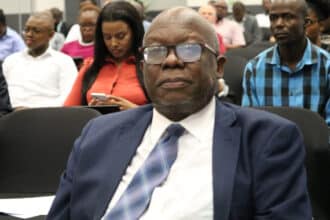“Nothing could be more important to an exploration or mining company than the sanctity of its license tenure and the rule of law in the jurisdiction it operates in,” says James M Bruchs, a Managing Director of Gchwihaba Resources (PTY) LTD, which recently took Botswana government to court over a mining license which the government has refused to renew.
Bruchs is also the chairperson of the company’s parent company, Tsodilo Resources Limited.
The matter is currently before a Maun High Court and with the judgment expected anytime from next week, Bruchs shares their expectations with The Voice senior reporter, FRANCINAH BAAITSE and what it would mean should they lose.
Likening the case to a recently similar matter in the neighbouring Namibia where Deep-South Resources Inc exploration programme was interrupted when Namibian government refused to renew its copper mining, but ultimately won the case against the government in court, Bruch is so hopeful that the wheels of justice will wind the same way in the Botswana case.
Q: The circumstances surrounding DeepSouth Mining in Namibia seem eerily like the issues that Gcwihaba is facing with our Ministry of Mines and Energy (MME)
Well, based on what I know, the facts behind the DeepSouth saga are a bit more diabolical than ours, as it was reported in the newspapers that there was a concerted effort by third parties to steal DeepSouth’s licenses and sell the project to foreign parties and current and / or former ministry employees may have been involved in the affair. I am not aware that the denial of our license is as the result of similar facts but what is similar to us both, is the sanctity of one’s license tenure and the rule of law.
What do you mean by the sanctity of a license tenure and rule of law?
First every mining or exploration company wants to be in a jurisdiction as in the case of Botswana, where the Mines and Minerals Act (Act) is clear and concise as to the scheme of obtaining a prospecting license or a mining license and secondly, that those tasked with carrying out the regulatory scheme do so in compliance with the Act itself. In the case of public companies such as ours, investors trust us with their money and assume that we are doing our homework to reduce the risks associated with their investment. We must then make judgments about where to employ this capital based on several factors of which the sanctity of the license tenure and the rule of law are at the top. This only stands to reason, as who would risk their exploration funds in jurisdictions that failed to follow their rules and regulations or where you couldn’t get redress in a court of law in the event they weren’t.
Are you saying that the procedures in the Mines and Minerals Act were not adhered to?
That is exactly what we are saying, and further to this, there has never been a legitimate issue with respect to our licenses regarding the legality of them being where they are. We have held them in one form or another since 2008, before and after any designation of the Okavango World Heritage Property, otherwise known as the core zone, or the area established around the core zone by the State Party, known as the buffer zone. The buffer zone established in 2014 encroached on our already existing licenses and our established resource.
If one reads the record, you will find that in 2013 and 2014, the State Party explicitly tells UNESCO in their application documents that mining and exploration are not prohibited in the buffer zone – plain and simple, end of story. We merely had to submit the government’s own documents to the court to prove our point.
What is the core zone and the buffer zone?
The core zone is the area designated as the Okavango World Heritage Property. Activities in the core zone are strictly limited and in 2018, after a period of negotiation, we reached an agreement with MME, to relinquish our licenses on the eastern side of the panhandle that existed in the core zone.
The buffer zone is an area established by the State Party (Government of Botswana) to provide an additional layer of protection to the core zone, where activities could take place and monitored to evaluate their impact if any on the core zone. In our case, the buffer zone encroached on our license by a couple hundred meters in width and in total covered about seven (7) sq km or an area equal to 0.018% of the land area taken up by the buffer and core zone. The area is indeed small, but it contains 169Mt of high-grade iron with a current net present value of $87M USD.
For those of your readers who have been to the panhandle, our project extends no further east than the hospital, the landing strip extension, and the shopping mall expansion all of which were built or expanded in the buffer zone after 2014 and of course the Mohembo bridge in the core zone itself. Our project will never impact the integrity of the Okavango World Heritage Property and there has been no showing that it ever would.
If this is so clear cut, why are you in court with MME?
That is a good question and to be honest, it has never been clear to me how we got to this point. I have been a practicing attorney for over 40 years and have never seen a case where there were no issues as to either the law or the facts. This is not a he said / she said case, it is about Gcwihaba being deprived its rights as per the Act and Botswana law. Again, if one would read the record, you will find that we agree with the State Party’s statements in 2013 and 2014 to UNESCO and that they (State Party) clearly agreed with our activities as our licenses have been renewed or regranted since 2008 to the present time, before and after any World Heritage Property designation. Further, we and our stakeholders have spent over $26M USD in exploration costs in the area and we have established a 441Mt iron resource compliant resource published in a NI 43-101 report. We have also indicated that the entire exploration target is between 5-7 billion tonnes with an approximate 30% recovery rate, and if all is borne out, it is one of the largest magnetite projects in the world and second largest in Africa with a mine life of 70 -100 years.
Maybe that is the problem – has it attracted any unwanted attention?
I would hate to think that, but you never know. I have worked in Botswana for 21 years and never witnessed such activity, so I hope it has not started with us. We will never really find out why the license was not granted. However, what I do know is that in 2014, the government stated that they wanted to develop this project with us and that in 2018, we approached MDCB about doing so. I do not want to say any more about that as we are still bound by a confidentiality agreement with MDCB but if one reviews the record on the landing page, they will learn more than I can say here.
So Mineral Development Company Botswana (“MDCB”) was going to partner with you?
Good try – read the entire record https://tsodiloresources.com/s/MMGE.asp.html and watch the video clip at https://player.vimeo.com/video/574156067 and draw your own conclusions.
What was Minister Moagi’s position in all of this?
You would have to ask him. What I can say is that if you look at his BTV interviews and his emails, texts, and WhatsApp messages on the landing page, he is probably one of the project’s biggest supporters. The Minster recognized, like those ministers who preceded him, that this project was a “game changer” for the country and its development was needed. So, it would appear that he is a huge fan of the project as are other government officials.
Where do things go from here?
After we submitted a voluminous record on the matter, we had a hearing on April 18, 2023, and I expect the judge’s decision sometime in August. From my view, there is no dispute as to the facts or the law and as you can see from the filings, it was the Department of Mines (DOM) decision to not award us the license and deny us our rights under the Act and justify it because “whatever inconvenience the applicant may suffer (by MME taking their license) is of a financial nature and pales into insignificance compared to the economy of the country since the economy of Botswana is amongst others, tourism driven“. Statements such as this should concern every prospecting or mining company in the country as the government is effectively saying through DOM, that some rights or want to be rights, are more important than established legal rights no matter what the law or the Act says. Also, if this was a matter of who had the most revenue, most jobs, most taxes paid in the next one hundred (100) years, the Gcwihaba Xaudum Iron Formation (XIF) project has the potential to dwarf that received from tourism.
At the end of the day, I do not believe that the judge will be swayed by the government’s rationale for its actions in denying us the license as that would effectively say that the rule of law does not exist in Botswana, and I do not think that is what Botswana stands for. I do believe that the judge will grant us the remedy we sought and order the license to be issued and that it is aligned in time with the four other licenses that make up the entire XIF project as per Sections 17 and 19 of the Act and to reset the clock to make up the time we have lost in this ordeal. We would not have brought the case unless we thought we would prevail on the merits.
This must have been quite an ordeal.
This is all unfortunate as it has resulted in a lot of lost time and productivity. The then Director of DOM said in a BTV interview 2 years ago https://player.vimeo.com/video/557203643 that she expected us to file our mining license within two years which we would have submitted by now and we would be in our Stage 1 production of ferrosilicon by the end of this year creating jobs, jobs and more jobs. What could be wrong with that? We have hit a road bump in the development of the XIF project, but I am confident that it will all work out. It is an important project for us as well as for Botswana.
I recently read excerpts from the statement made by the Bank of Botswana Governor, Moses Pelaelo, at the Annual Economic review briefing, and I believe our (Tsodilo’s) goal of becoming a major supplier of an ultra-high grade +67% Fe product to the industry and doing what we can to reduce greenhouse gas emissions (GHG) by becoming part of the “green steel” movement, fits nicely in the country’s Vision 2036 goal of doubling GDP by 2036.

THE STORY BEHIND THE DISPUTE
The verbatim statements below have been obtained from the court filings and Tsodilo’s litigation landing page https://tsodiloresources.com/s/MMGE.asp.html
On June 30, 2021, pursuant to Section 17 and 19 of the Mines and Minerals Act (MMA), Tsodilo Resources Limited (“Tsodilo” or the “Company”) (TSX-V: TSD) (OTCQB: TSDRF) (FSE: TZO) Botswana subsidiary Gcwihaba Resources (Pty) Ltd. filed its renewal application for 5 of its of seven metal licenses.
The company relinquished 50% of its license area as was in full compliance with its work program and expenditures. Gcwihaba was informed in late November 2021 that 4 of the 5 licenses were renewed to be effective January 1, 2022, but PL020/2018 was not renewed. PL020/2018 is the license which contains the 441MT inferred Fe resource that comprises part of the company’s Xaudum Iron Formation.
On April 26, 2022, Minister Moagi informed Gcwihaba that “Kindly note that the coordinates submitted in the application for renewal pf prospecting License No. 020/2018 are encroaching into the buffer zone, of the Okavango Delta which is listed as a word Heritage Site. Prospecting activities are prohivbited within the buffer zone of the Delta, or if permitted, they areto be subjected to stringent Environmental Impact Assessment measures, in accordance with the provisions of te Environmental Assessment Act of 2010 and Environmental regulations of 2012 for the Department of Environmental Affairs (DEA)”. In light of the above, I am not in a position to renew the Prospecting Licenses for as long as the submitted coordinates fall within the buffer zone of a World Heritage Site”.
On April 27, 2022, Gcwihaba advised Minister Moagi that “PL020/2018 has existed in one form or another since 2008 and always in the area currently known as the buffer zone. Chronologically, the buffer zone encroached on our license area as our license existed six (6) years prior to the buffer zone being established by the State Party in 2014. In fact, a compliant NI 43-101 441Mt resource report was prepared and filed with MMGE prior to the buffer zone and the OKWHP being established. For clarification, only the area known as the core zone is part of the OKWHP and it is defined in and known by as the Property in the UNESCO documentation. See, https://whc.unesco.org/en/list/1432/documents“.
“We (Gcwihaba) agree with your sentiments that if mining were to take place within the buffer zone that an Environmental Impact Assessment (EIA) must first be conducted and made part of any mining application and further an Environmental Management Plan (EMP) must be filed before exploration activities are to be conducted. The foregoing is consistent with the Mines and Minerals Act, the Environmental Assessment Act of 2010 and the Environmental Regulations of 2012 and are applicable not only to us but to all resource activities in the country. However, under existing law, before either an EIA or a EMP can be conducted and approved, a company must first have the prospecting license”.
“Your sentiments are indeed consistent with the State Party’s position on these issues as codified in the following documents: Nomination dossier to UNESCO for inscription into the World Heritage List (submission by Republic of Botswana, 2013) [Page 30] “The Ministry of Energy, Mineral and Water Resources has issued several mineral prospecting licenses to exploration companies for concession areas within the buffer zone of the site. No licenses have been issued within the core zones of the property. Should an application to mine within the buffer zone arise, an Environmental Impact Study (EIA) will be required as part of Botswana’s EIA Act, which would address concerns relating to the World Heritage property. Also, the matter would be referred to the World Heritage Centre (WHC) for their advice.” (emphasis added) and from the same report, [Page 405] The government of Botswana through the Ministry of Minerals, Energy and Water Resources has taken a position that it will not issue any new mineral concessions within the Core area of the delta. The Ministry will further engage with the holders of the few existing licenses within the Core area of the delta with a view to eventually expunge those portions of the licenses which overlap the core. Regarding the buffer area, stringent environmental protocols and practices will be adhered to, to protect the integrity of the Delta. (emphasis added). In addition, WORLD HERITAGE NOMINATION – IUCN TECHNICAL EVALUATION KAVANGO DELTA (BOTSWANA) – ID No. 1432 [April 2014] (page 12) “Mining activities including prospecting will not be permitted within the [core zone] property. Furthermore, potential impacts from mining including concessions in the buffer zone and outside the buffer zone need to be carefully monitored and managed to avoid direct and indirect impacts to the property, including water pollution.” (emphasis added)“.
“It is clear from the State Party’s submissions to UNESCO since 2013, that both mining and prospecting licenses can exist within the buffer zone. Accordingly, we are agreeable, as we have always been, to conduct our activities consistent with the prevailing law and we assure you that our goal is to advance our project in an environmentally friendly manner. Accordingly, as we are in full compliance with all laws, we respectfully request that PL020/2018 is renewed as we have proposed as it is now almost 11 months since we filed for its renewal. If there is further delay in awarding the license, we request that the State Party reimburse us for its’ taking what is legally ours, the exploration costs (+25M USD) and the present value of the in-situ value ($6-7Billion USD) of that portion of the resource in the buffer zone.”
“Thank you again for your attention to this matter and please be assured that we are committed to developing our project in full compliance of all relevant existing laws. In addition, Gcwihaba adopted Occupational Health and Safety Assessment Series (OHSAS 18000) and the International Financial Corporation (IFC) Performance Standards and Environmental, Health and Safety Guidelines when IFC, a member of the World Bank became a shareholder of Gcwihaba’s parent company, Tsodilo Resources Ltd. in 2010.”







